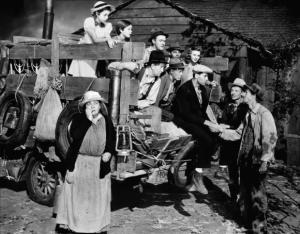All Souls’ Day
Hungary, 1989
We drank brandy for breakfast, ate smoked bacon,
raw onions, crusty petals of heavy
bread, and apples we picked in the orchard
at dawn. Your nephew fed field mice
to a wounded owl he kept caged in the garden.
There was a cross on top of the hill. A bronze soldier
rode a bronze horse that reared in the cobbled square,
and he pointed his sword toward the yellow church tower.
You showed me where there was once a well
where bodies were stacked and layered with lime
to prevent the spread of disease while the war
wore on. The grass there seemed like the grass
all around. I wanted to say I was sorry.
If it rained that day, I can’t even remember.
I only know where I knelt and let
my sweater slide to the ground while
you smiled and fumbled with buttons.
By daylight, the graveyards blazed
with chrysanthemums. Even there, the dead
were stacked in the earth—the land was needed
for feeding the living. On the late ride back
to Budapest, I could smell the sausage
your cousin had packed, could hear wine bottles clink
when we took the curves, and I made up words
to go with the song of a gypsy cimbalom:
that night the stars abandoned the sky
for the candle-lit hills where the dead promenade.
This poem was originally published in the Jefferson Journal. If you enjoyed this piece, please comment here, follow this site, or feel free to share.










 Sally Landaker’s The Cave of the Crystal Skull is an adventure written for middle grade readers that explores consciousness and parallel realms. While a quest involves a search for something of great value as its mainspring, adventures turn on the undertaking of a hazardous enterprise, one whose outcome is doubtful.
Sally Landaker’s The Cave of the Crystal Skull is an adventure written for middle grade readers that explores consciousness and parallel realms. While a quest involves a search for something of great value as its mainspring, adventures turn on the undertaking of a hazardous enterprise, one whose outcome is doubtful. Abandoned by her Mexican father, Cat has been raised by a drug-addicted mother and grown up tough in the streets of Phoenix, AZ. When her mother is taken to prison, Cat is forced to move to a small town and live with her Native American grandmother, a woman she has never met. To further complicate matters, the town is an isolated, predominantly white, ranching community in Northern California.
Abandoned by her Mexican father, Cat has been raised by a drug-addicted mother and grown up tough in the streets of Phoenix, AZ. When her mother is taken to prison, Cat is forced to move to a small town and live with her Native American grandmother, a woman she has never met. To further complicate matters, the town is an isolated, predominantly white, ranching community in Northern California. Maybe it’s because I’m Irish that the absence of irony in the joke left me stymied. Irony is the use of language to express its literal opposite, a deliberately contrarian act for the purpose of emphasis, amusement, or mockery.
Maybe it’s because I’m Irish that the absence of irony in the joke left me stymied. Irony is the use of language to express its literal opposite, a deliberately contrarian act for the purpose of emphasis, amusement, or mockery.

 There on page 1058, through smoke and dust of war, I watched Petya on his horse, galloping across the manor courtyard, slip sideways in his saddle, the horse rearing, the boy falling to the wet ground, his head pierced by a bullet. Tolstoy sets the expendable character’s death against the improbable happiness Pierre finds with Natasha in the end.
There on page 1058, through smoke and dust of war, I watched Petya on his horse, galloping across the manor courtyard, slip sideways in his saddle, the horse rearing, the boy falling to the wet ground, his head pierced by a bullet. Tolstoy sets the expendable character’s death against the improbable happiness Pierre finds with Natasha in the end.

